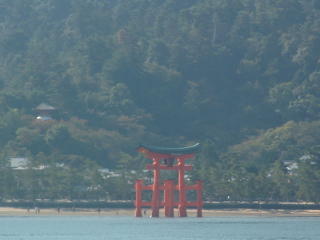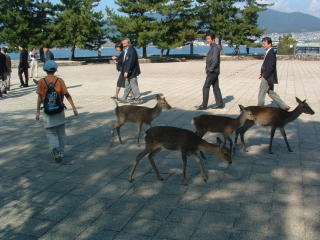Miyajima a gateway to traditional attractions

It was a dream come true when I spotted O Torii (Grand Gate) as the ferry neared the island of Miyajima. I recalled a session during my first year in architecture school that discussed the gate as an example of special ways to greet visitors.
O Torii is the gate to Itsukushima Shinto shrine, but you cannot walk through it because it stands in the sea, some 200 meters in front of the shrine's main hall.
The complex itself is built on stilts on the beach so during high tide you might think the shrine is floating on the sea.
It was built in the first half of the 6th century, but general Taira-no-Kiyomori remodelled it into the present structure in 1168. The shrine and O Torii are easily recognizable for the bright vermilion color, showing the artistic beauty of the Shinden architecture style.

Walking out from the ferry terminal along the shore, visitors will soon be greeted by a herd of tame deer on the way to the shrine (tame they may be, but they can get quite aggressive in their pursuit of a snack).
The shrine itself is a formal, symmetrical wooden structure with hallways connecting sections to the main hall. There is an open deck in front of the main hall with a direct view to O Torii, and a raised stage on the terrace for Shinto religious festivals.
One of the most dramatic festivals is the Kangen-sai music festival, held annually in July or August, featuring court dances and music. During the festival, the Itsukushima deity is taken on a boat journey to visit other shrines located on the nearby islands of the Seto Inland Sea.
Itsukushima shrine was designated a World Heritage Site by UNESCO in 1996. In addition, the Japanese government also designated 30-square-kilometer Miyajima Island, about a one-hour ferry ride from Hiroshima, a special historic site and a special place of scenic beauty.
Leaving Itsukushima, there is the Daiganji Buddhist temple to the right and the Homotsukan Treasure Hall to the left. Two celestial guardians stand watch at Daiganji's gate, believed to curse visitors who have committed evil deeds in the past.
The Homotsukan Treasure Hall displays the Heike clan's Buddhist sutras as well as treasures dedicated by clan members to the Itsukushima shrine as prayers for prosperity.
The collection has 130 works of arts (paintings, sculptures and handicrafts) designated as important cultural properties by the Japanese government.
Close by is the Senjokaku shrine and its five-storied pagoda. The shrine, also known as Hokoku shrine, is a library of Buddhist sutras built by Hideyoshi Toyotomi for the war dead.
The 27-meter-high pagoda was built in 1407 in a blend of Japanese and Chinese architecture. There is a full-color image of Buddha on the inside wall.
Take a cable car to Mt. Misen; the mountain stands at 530 meters above sea level and offers a magnificent view of the island. The mountain itself is considered sacred.
At the foot of the mountain is Momijidani Park, covered by primeval forest. It is best to visit the park in autumn as there will be a splendid view of red-tinted maple leaves. From spring to early summer, cherry blossoms provide more magnificent scenery.
As for souvenirs, visitors can buy the popular confectionery momiji manju in the shape of maple leaves and shakushi senbei (rice scoop-shaped crackers).
The island is renowned for its method of making the wooden rice scoop, devised by a Buddhist priest named Seishin. The particular technique ensures that the scent of the wood is not transferred to the rice. The scoop is also used as a good luck talisman.
Published on The Jakarta Post on Sunday, November 23, 2003
0 Comments:
Post a Comment
<< Home